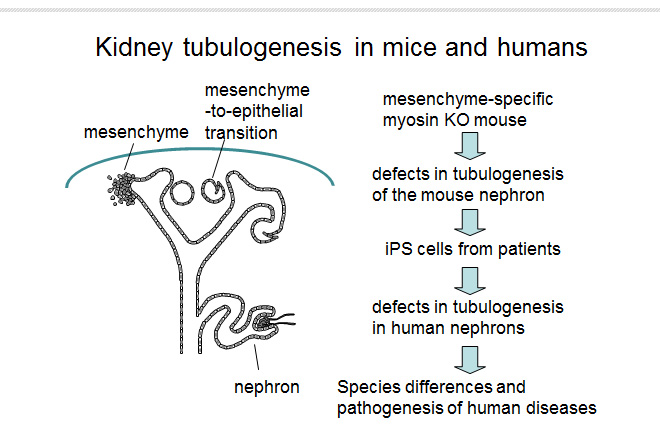|
HOME > Proposed research projects > 2014-2015: Proposed research projects 15
 2014-2015: Proposed research project 15Cytoskeletal regulation of kidney tubulogenesis in mice and humans
Purpose of the Research ProjectThe kidney is generated through mutual interactions between two precursor tissues: the metanephric mesenchyme and ureteric bud. The mesenchyme is transformed to epilethelia and forms a lumen (epithelial-mesenchymal transformation, MET), and connected to the lumen derived from the ureteric bud to form a functional unit, the nephron. We found that mice deficient for Kif26b, a kinesin expressed in the mesenchyme, lacked the kidneys and that Kif26b bound the non muscle myosin heavy chain II. The purpose of this study is to analyze the roles of cytoskeleton in the tubulogenesis, including MET, during kidney development in mice. We will also utilize a newly developed method to induce myosin-deficient nephrons from patient-derived iPS cells, to reveal the species differences of the kidney tubulogenesis and pathogenesis of the human diseases. Content of the Research ProjectWe plan to analyze the conditional knockouts of myosin genes to analyze tubulogenesis in the embryonic kidney. We will generate the mesenchyme-specific mutants and examine the polarity and the MET process. At the same time, we will establish iPS cell lines from the patients with myosin mutations and reconstruct human nephrons in vitro, by utilizing the protocol that we have recently established. Expected Research Achievements and Scientific SignificanceMost organs are generated by interactions between the mesenchyme and epithelia, but the kidney is unique in that the mesenchyme is also converted to epithelia and connected to the epithelia of ureteric buds. Since the molecular mechanisms underlying the morphogenetic process of nephron formation remain largely unknown, this project aims at elucidating the roles of cytoskeleton in MET using the mutant mice, and will provide new insights on the formation of the three-dimensional organs. In addition, nephron formation in vitro from patient-derived iPS cells would help reveal the pathogenesis of the human diseases.
|








